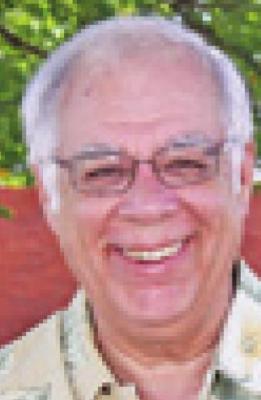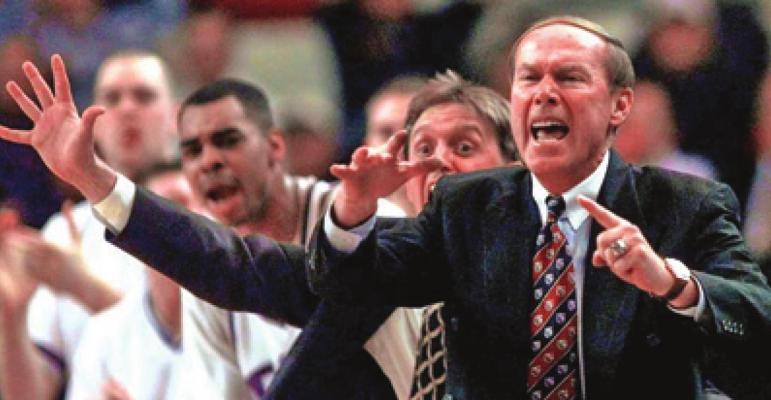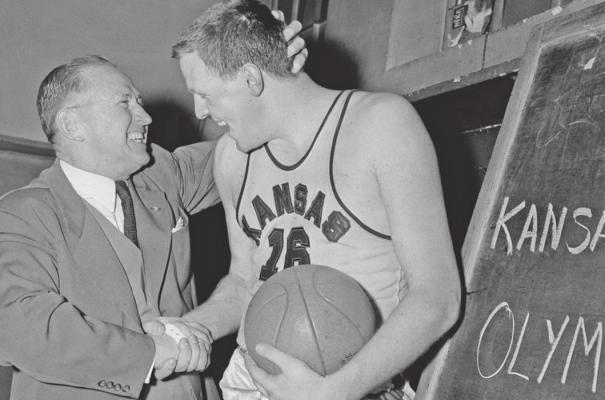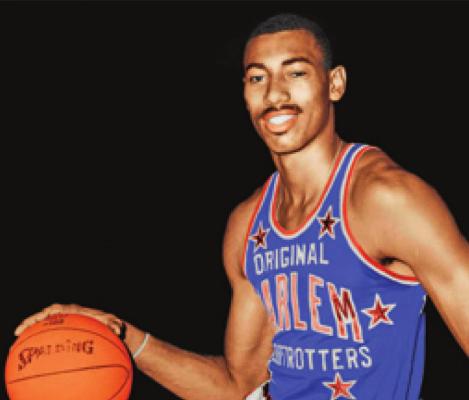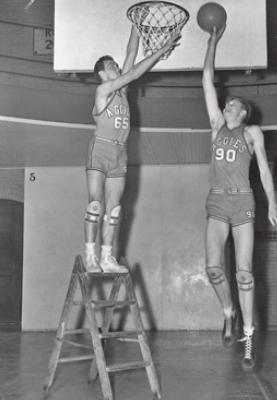Doing without the March Madness excitement
I have missed filling out an NCAA tournament bracket. Never mind that my bracket always proves to be worthless. Filling out a bracket is just something one normally does this time of year. The horrendous coronavirus tragedy has interfered with our routines in many ugly ways. Prayers go out to all the victims of the plague now and in days to come.
One of the things I don’t miss is for my friends to come to me seeking advice about how they should fill out their brackets. Always, always, I have preceded anything I might say with a disclaimer — “I’m not the one to ask. I always do terribly in making bracket selections.” Often friends will persist and I reluctantly make suggestions. I remember a dear friend in my church wanting to know about the possibilities for the Oklahoma State Cowboys that year. I assured her that the Cowboys had a very good team and that they might go far. She had a bet with one of her very good friends and lost that bet based on my advice. All I could do was say, “I told you not to ask me.”
Even with the frustration of my ineptitude, proven to be true year after year, I do miss the NCAA Tournament. There’s a lot about this March that doesn’t feel right.
I find my mind going back to March Madness in past years, reliving some notable experiences over time.
I have memories of the 1945 and 1946 NCAA tournaments — let me be clear, I was a toddler in these years and don’t actually remember the events as they happened.
However, the champions in both 1945 and 1946 came from Oklahoma A&M as it was known back then. I have mentioned here many times that my Dad was a native Oklahoman and although his first love was the OU Sooners, he was proud of his native state and spoke of the A&M championships with pride.
My memories have to do with him singing the praises of the Cowboys head coach Henry Iba, who he thought may have been the best coach in the nation.
He told about a player on the A&M team in those championship years, a sevenfooter named Bob Kurland. It was because of the way he described the player that Kurland’s name was indelibly etched in my memory, just as if I had actually been listening to radio broadcasts of the tournament.
Looking up the 1945 tournament, I see that Iba’s team was one of eight teams invited to the Big Dance.
The Cowboys, or Aggies as they were often called then, played Utah in the first round, won that game 62-37, then played Arkansas in the semifinals and won that one 68-41. The championship game against New York University wasn’t easy but A&M eventually prevailed 49-45. The games against Utah and Arkansas were played in Kansas City, while the championship game was played in Madison Square Garden, virtually giving NYU home court advantage.
Kurland was named the MVP of the tournament after scoring 22 points in the championship game. Cecil Hankins of A&M scored 15 points. NYU’s Dolph Schayes, who later became an NBA legend, was held to five points by Mr. Iba’s defensive strategy.
In 1946, again the tournament involved eight teams. Oklahoma A&M, which finished the year with a 31-2 record, played Baylor and won 44-29 in the opening round. Next came a 52-35 victory over California in the semis and finally a 43-40 win over North Carolina in the championship game. Again Kurland was the MVP and again the games were played in Kansas City and in New York. Kurland had scored 23 of his team’s 43 points.
The first NCAA tournament that I actually remember listening to was in 1952. That was the year that Kansas picked up its first national title defeating St. John’s 80-63. Being from Kansas I knew the names of the Kansas players. Clyde Lovellette was the star. The supporting cast were Charlie Hoag, Bill Lienhard, Dean Kelley, Allen Kelley, Bob Kenney (who was from Winfield) and Dean Smith, who was a little-used substitute who later became a coaching legend at North Carolina.
Lovellette was the MVP of the championship game. What I remember especially about this team is that many of them participated in the 1952 Summer Olympics in Helsinki. In those years, all members of the NCAA championship team were invited to the Olympic tryouts and most of the KU team made the cut. The coach of the Jayhawks in 1952 was Phog Allen, the namesake of the famous Allen Fieldhouse in Lawrence. Lovellette went on to be an NBA standout and I proudly followed his pro career.
The next year KU again made it to the national championship game behind the leadership of junior B. H. Born. Born had been Lovellette’s backup in 1952. In the 1953 title game, the Jayhawks lost by one point (69-68) to Indiana, but Born was the tournament MVP. Again I remember listening to the KU-Indiana game on the dining room radio.
Kansas again made it to the national championship game in 1957. That was Wilt Chamberlain’s sophomore year at KU. The tournament had expanded to include 23 teams by then. Starting in the Midwest Regional, Kansas beat SMU 73-65 in overtime, then defeated Oklahoma City 81-61 to advance to the Final Four which was played in Kansas City. By the way, I learned that Oklahoma City played Loyola of New Orleans in the opening round and the game was played at Capitol Hill High School in OKC.
In the Final Four, Kansas played San Francisco in the semis and won relatively easily 80-56. The championship game has been described by many as having been the greatest game played in NCAA history. It went three overtimes with North Carolina defeating the Jayhawks 54-53. I remember that my folks allowed me to stay up to hear the entire game, although it had gone a ways past my bedtime. Kansas led by a point, but Carolina’s Joe Quigg was fouled in the final seconds and made two free throws to give his team the victory. I hadn’t remembered Quigg’s name, but I vividly remember those free throws. Two of Chamberlain’s teammates were Bob Billings and Blaine Hollinger, both from Russell. Later in my life I worked in Russell and got to know Billings’ mother and Hollingers’ parents quite well. In fact, Mrs. Hollinger was the organist at the church I attended.
That was Chamberlain’s sophomore year. KU didn’t even get to the NCAA tournament the next year as only conference champions qualified. The 1958 Kansas State team had two All-Americans in Bob Boozer and Jack Parr and the Wildcats won the Big 7 championship that season. K-State made it to the Final Four, but lost to Elgin Baylor’s Seattle team in the semis and then lost to Temple in the 3rd-place game. Kentucky. coached by Adolph Ruppdefeated Seattle in the championship.
I have recounted the 1964 NCAA Tournament in this space numerous times. Kansas State made it to the Final Four that year and lost to UCLA and Michigan in the two games it played there. K-State had beaten Wichita in the Mid-West Regional finals.
There were many memorable NCAA tournaments after 1964, but the one I remember quite well and I know basketball fans in Oklahoma remember was the 1988 tournament.
The championship game involved Kansas and Oklahoma and Kansas, which was known that year as Danny and the Miracles, indicating that Danny Manning was the primary reason they had even made it to the finals.
The tournament involved 64 teams by then and Oklahoma was a No. 1 seed in the Southeast Region. The other top seeds were Arizona in the West, Purdue in the Midwest and Temple in the East. Kansas was seeded No. 6 in the Midwest Region.
The Sooner starters were guard Mookie Blaylock. 6-foot-10 post Stacey King, Harvey Grant, Rickey Grace and Dave Sieger. They had roared through their regular season and compiled a 35-3 record. They had been ranked No. 1 on at least one occasion during the year. They started the NCAAx with a 94-64 win over Chattanooga. The next three games were wins— 107-87 over Auburn, 108-98 over Louisville and 76-59 over Villanova.
Kansas on the other hand had struggled at times and came to the tournament with 11 losses. The Jayhawk starters were Manning, Kevin Pritchard, Milt Newton, Chris Piper and Lincoln Minor. They started off by beating Xavier 85-72. From there it was a 61-58 win over Murray State, a 77-64 win over Vanderbilt and then a 71-58 victory over old rival Kansas State in the Regional Finals. Current OU coach Lon Kruger was the K-State coach that year.
The Final Four was played in Kansas City, about 40 miles from the KU campus. Despite that fact, Kansas was a heavy underdog not expected to fare well with its first opponent, Duke. But the Jayhawks won that game 66-59. Meanwhile Oklahoma got to the championship contest with an 86-78 win over Arizona.
I am not a betting man, but I’m told that when Kansas defeated Oklahoma 83-79, it beat the largest point spread in NCAA history. Those who did bet on such things didn’t think the Jayhawks had much of a chance against the highpowered Sooners.
Since I lived in Kansas at the time, I witnessed a lot of celebrating. This year we turn our thoughts to celebrating those brave healthcare workers that are doing all they can to help us through this time.

